

Canon Powershot G12 Review
Image Quality
Noise
Below are 100% crops of JPEG images taken at ISO settings from 100 to 3200. ISO 80 and 100 are very hard to tell apart so I left ISO 80 out. ISO 6400 and 12800 are available, but only in 2.5MP reduced resolution mode and I'll get to them later.
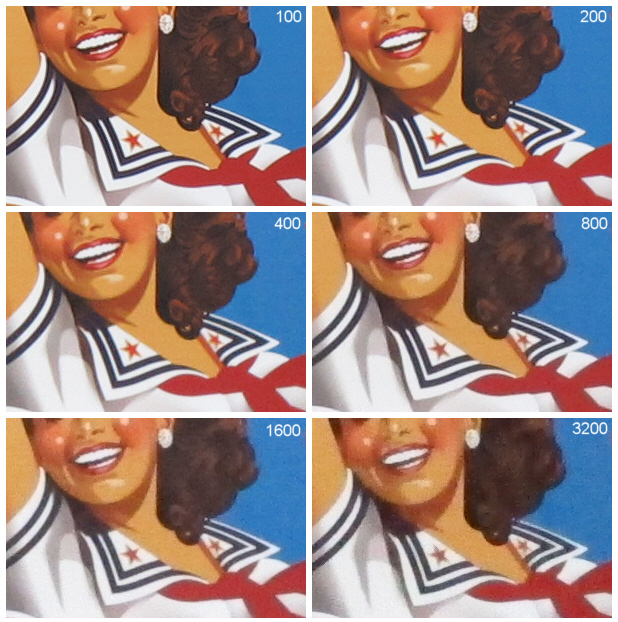
As I think you can see, noise is low even at ISO 1600 and 3200, though that's mainly due to some fairly aggressive noise reduction which is applied to higher ISO images. This results in low visible noise but a softening of the image. However noise is low and image quality pretty good all the way through ISO 800.
Shooting RAW gives a lot more flexibility. The images below are 100% crops from images shot at ISO 3200 and processed in Canon's DPP software with varying amounts of noise reduction. A JPEG version is also shown as it came out of the camera.
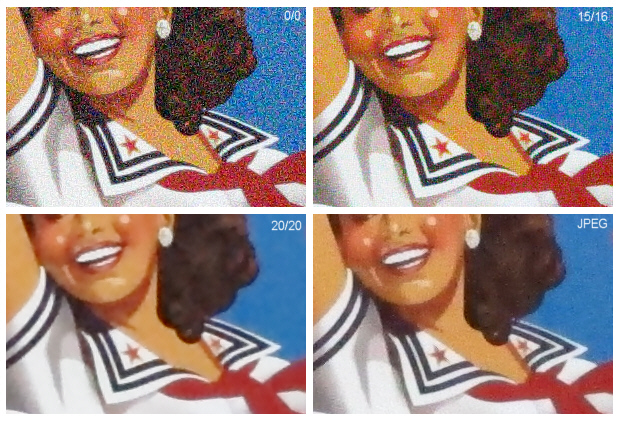
The numbers in the upper right (e.g 0/0) are the amounts of luminance and chrominance noise reduction respectively. Maximum on both scales is 20. At 0/0 noise is quite evident, but the image is sharp. At 15/16 noise is reduced at the cost of a little sharpness. Full noise reduction is 20/20 and while noise is almost totally gone, sharpness has suffered.
Even at low ISO settings there is still something to be gained from shooting RAW. The images below compare 100% crops from an optimally processed RAW image with the camera default JPEG image. The RAW file produces a cleaner and sharper image.
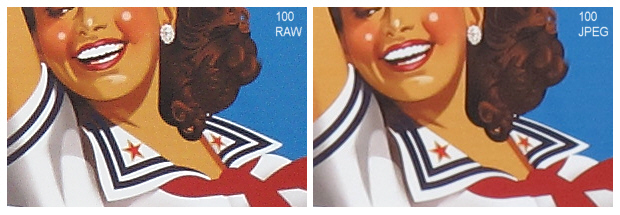
As I mentioned earlier, ISO 12800 is possible in low light mode where the output image size is reduced to 2.5MP by combining 4 pixels into 1 to lower noise. In normal (10MP) mode, ISO 3200 is the lowest ISO that can be set. However you can shoot at ISO 3200 with -2EV of exposure compensation dialed in. Normal mode allows you to save the image as a RAW file which can then be corrected for the 2 stops of underexposure in DPP. This gives you an effective ISO 12800 as far as exposure settings are concerned.
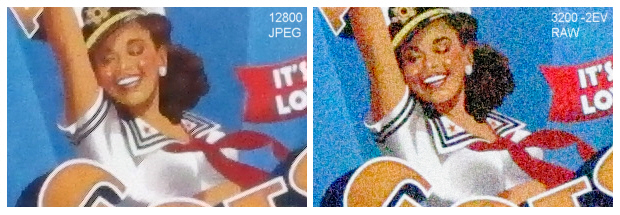
The image on the left is a 100% crop from the out-of-the-camera 2.5MP JPEG shot in low light mode at ISO 12800. On the right is a 50% crop from the 10MP image shot at ISO 3200 with 2 stops underexposure processed in DPP. The JPEG is lower in noise, but the image is soft and the colors are muted. The processed RAW image shows more noise, but is sharper and has brighter colors.
Below is the image shot at ISO 3200 with -2EV exposure compensation (effectively the same exposure as a shot at ISO 12800 with no EC). This is the whole frame but the image has been downsized to fit the page. Certainly acceptable for web use.

Sharpness, Distortion and Chromatic Aberration
At the telephoto end of the range distortion and chromatic aberration are very low and unlikely to be noticed, even in large prints. Sharpness is good from center to edge.
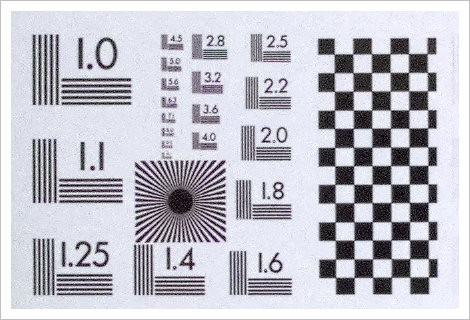
100% crop from image center at wideangle setting. RAW image converted to JPEG in RAWTherapee
For the technically inclined, the 2.5 line group above represents about 164 lp/mm at the sensor and the 2.8 line group represents about 184 lp/mm. In terms of LPH (lines per picture height), a resolved 2.5 group corresponds to around 2500 LPH. For the less technically inclined, the above numbers show that the lens and sensor of the G12 perform well together and produce a very sharp image.
At the wideangle setting there can be noticeable barrel distortion which gets stronger the closer the focus distance. Chromatic aberration is visible as purple/magenta fringing at the edges of the frame, but it's not excessive. However if you shoot RAW rather than JPEG, DPP has built in correction for both distortion and chromatic aberration (as a function of focus distance) and it does an excellent job.
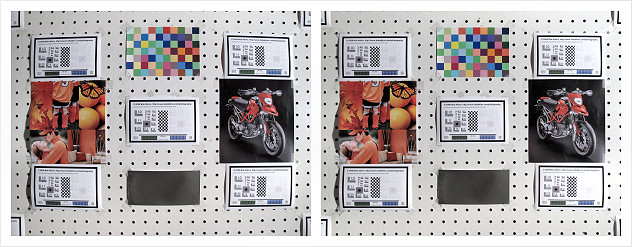
Left: JPEG as shot at 28mm Right: RAW image with auto corrections
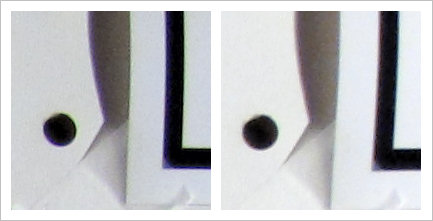
Left: 100% crop from extreme corner at 28mm JPEG
Right: 100% crop from extreme corner at 28mm RAW corrected in DPP
Images are sharpest with the lens wide open. Due to the small sensor size, diffraction causes some image softening as the lens is stopped down. Overall the image quality, especially in the center of the image, is very good. At low ISO settings the image is certainly comparable to that which you'd expect to get from a DSLR with a similar pixel count. Where the larger sensor DSLR wins out is at higher ISO settings, where the lower noise results in higher quality images.
So for the best image quality, shoot RAW, shoot at low ISO and shoot wide open.
Infra Red
Though certainly not an IR camera, it turns out that the G12 has enough IR sensitivity for handheld shooting at reasonable ISO settings when used with a filter like the Hoya 720. Here's an example:
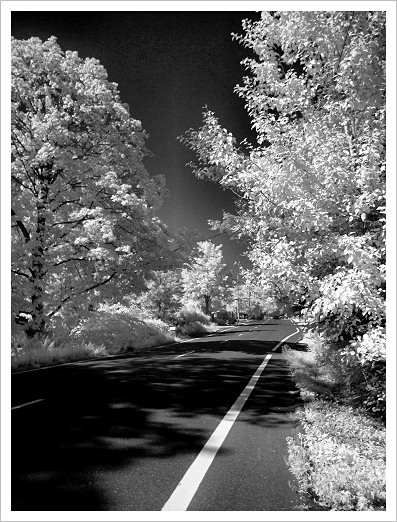
This was shot with a Hoya 720 filter at ISO 400 on a sunny day. Shutter speed was 1/5s at f2.8 and that's fast enough for the G12's image stabilization to allow sharp handheld images. The image out of the camera is low in contrast, so the above example was processed to optimize the image. It was shot as a monochrome JPEG, but you can shoot in color if you want and tweak the color balance to give a look like the image below:
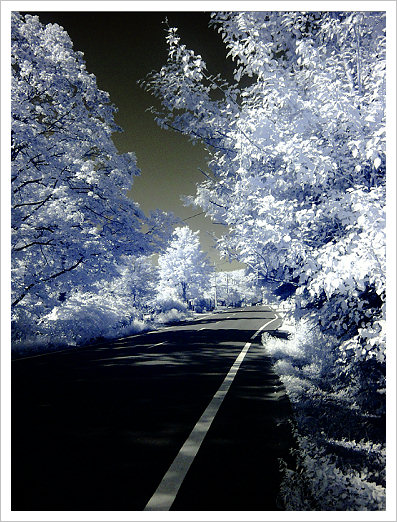
Canon Powershot G12 with Hoya 720 IR filter. Shot in RAW and processed in DPP. ISO 400, 1/3s @ f2.8
Shooting at ISO 80 would be quite possible, but would require using a tripod and turing off the IS (IS will result in slow image drift at long exposure times, so turing off IS is recommended). So while the G12 isn't an IR camera, it can certainly be used handheld to obtain IR images as long as you keep the ISO up in the 400 region or higher.
NEXT => Conclusions
• Canon Poweshot G12 at ADORAMA
